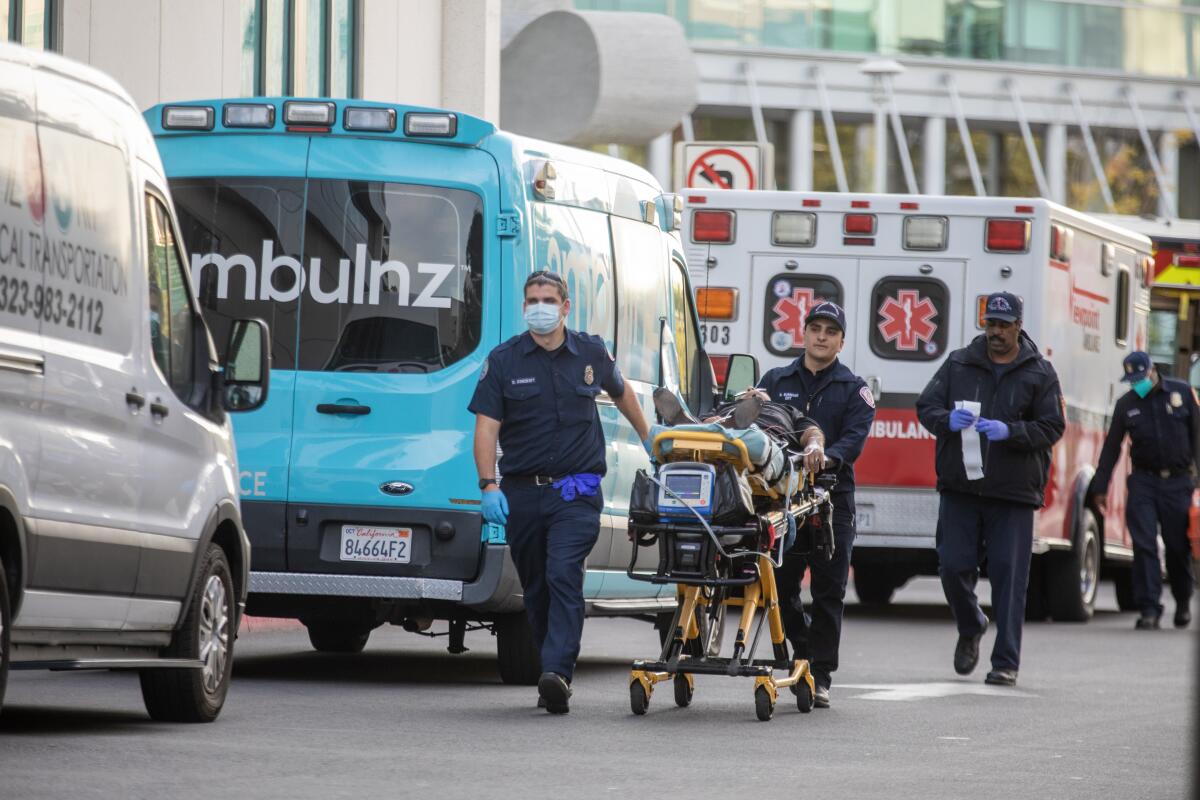What investigators know about the Palm Springs bombing suspect

- Share via
It has been four days since the bombing of the American Reproductive Centers fertility clinic in Palm Springs left one dead and at least four injured in what the FBI called “an intentional act of terrorism.”
You're reading the Essential California newsletter
The most important California stories and recommendations in your inbox every morning.
You may occasionally receive promotional content from the Los Angeles Times.
DNA tests of body parts found outside the facility showed that the suspect, 25-year-old Guy Edward Bartkus, was killed in the blast.
Law enforcement sources told The Times they are looking into videos, audio files and other online postings attributed to Bartkus as they try to determine the motive for the attack. They also are exploring whether incidents in Bartkus’ childhood laid the foundation for later beliefs in “antinatalism,” an idea that procreation is wrong in an overpopulated world struggling with environmental harm and violence.
Here’s what we know about the investigation:
Videos show the suspect was fascinated with explosions
YouTube videos probably posted by the suspect depict M-80s exploding in desert sand, a hydrogen balloon being set ablaze, and a bucket of radioactive uranium ore that causes a radiation detection device to wail.
The voice in the videos, my colleagues have reported, is the same as the one captured on a 30-minute audio file that authorities believe was made by Bartkus.
In the audio file, the speaker gives the following reason for bombing a fertility clinic: “Basically, it just comes down to I’m angry that I exist and that, you know, nobody got my consent to bring me here.”
The suspect’s father told us his son had a childhood obsession with pyrotechnics
In an interview with my colleague Jenny Jarvie, the suspect’s estranged father, Richard Bartkus, said the boy, then 9, set his family’s Yucca Valley home on fire.
In 2008, the elder Bartkus said, his son took some matches outside his family’s rented house to conduct what he called an experiment. The boy burned down the house, a shed, and all of the family’s possessions, Richard Bartkus said.
“It destroyed the whole house,” he said. “So he didn’t feel good about that at all.”
But his son, Richard Bartkus said, continued to ramp up his experiments with explosives — making rockets, stink bombs and smoke bombs. The elder Bartkus said he became more strict with his son, worrying that his experimentation with increasingly powerful explosives was getting out of hand.
Court records offer a window into the family discord that marked the suspect’s youth, including his parents’ messy divorce and allegations of verbal and emotional abuse.
After Bartkus’ mother moved out of the family home with her son and daughter in 2012, records show, she obtained a restraining order against Richard Bartkus, saying she felt “scared of his irrational behavior.”
Richard Bartkus disputed many of her allegations.
Investigators don’t yet know where Bartkus obtained a massive cache of explosives
The investigation also is focused on how Bartkus obtained a massive cache of explosives, some of which were found in a house in rural Twentynine Palms that he shared with his mother.
My colleagues have reported that investigators are likely to look into Bartkus’ proximity to the Marine Corps Air Ground Combat Center in Twentynine Palms, which is touted as the largest Marine training base in the world.
Capt. Johnathon Huizar, a spokesman for the combat center, said there is no record of Bartkus — who was not a Marine — entering the base. Huizar would not comment on whether there have been any recent instances of lost or stolen explosives.
In 2021, 10 pounds of plastic explosives vanished from the base during a training exercise and were suspected to have been stolen, according to news reports. The material was ultimately recovered, according to news reports, but the military has released little information about the episode.
Today’s top stories

L.A. County is paying off millions in medical debt
- Did you get a letter in the mail from the County of Los Angeles with the word “Undue” in bold blue? It’s not a scam. It’s a notification that your medical debt was cleared by the county.
- More than 134,000 Los Angeles County residents began getting notices in the mail Monday as part of the first wave of medical bill forgiveness made possible by the county’s Medical Debt Relief Program.
- Keep your eye out for the letters over the next few weeks.
Mosquitoes are breeding in pools in the Eaton fire area
- San Gabriel Valley vector officials have identified 1,475 swimming pools at risk of providing breeding grounds for mosquitoes in the Eaton fire burn area.
- Officials say they don’t have the funds needed to provide sufficient treatment for all the pools that are now possible mosquito hothouses.
- That has sparked public health concerns in an area that has recently seen increases in locally acquired cases of dengue fever, a potentially fatal mosquito-borne disease.
Offshore oil operation near Santa Barbara resumes production after 10 years
- Almost 10 years to the day after a massive oil spill fouled the Santa Barbara coastline and prompted the closure of several drilling platforms, a Texas-based company says it has resumed crude oil production in nearby federal waters.
- The resumption of oil production off Santa Barbara coincides with a push by the Trump administration to expand fossil fuel production and roll back clean energy initiatives.
What else is going on
- Six doctors weigh in on Biden’s cancer diagnosis, how it may have arisen and his treatment options.
- ‘Just a normal family’: Neighbors react to allegations of child torture at a Victorville home.
- Aryan Brotherhood leaders ordered murders from California prisons. Can federal prison stop them?
- Appeals court halts Temecula school district ban on critical race theory.
- A Cal State Fullerton freshman drowns during a fraternity trip to Lake Havasu.
- Lucas Museum layoffs hit 14% of its full-time staff, including the education team.
- With Father’s Day approaching, we’re eager to hear your stories about the father figures who have shaped you.
- Where are Billy and Tina? L.A. Zoo’s elephant enclosure appears empty amid relocation saga.
- George Wendt, Emmy-nominated actor known for playing Norm on ‘Cheers,’ has died at 76.
Commentary and opinions
- It’s not just Biden. There’s a history of presidential health cover-ups, argues columnist Mark Z. Barabak.
- Ending birthright citizenship will mostly affect U.S. citizens, argues guest columnist James Thomas Snyder.
This morning’s must reads
In ‘Diet, Drugs, and Dopamine,’ former FDA Commissioner David A. Kessler offers a comprehensive guide to weight loss.
Other must reads
- 2025 Emmy predictions: Who could win for best drama actress, best drama actor and best drama series?
- What Elmo, Netflix and HBO Max tell us about the state of streaming.
- This rare, hands-on recording museum highlights the sonic legacy of guitar god Les Paul.
For your downtime

Going out
- Gardens: 26 awe-inspiring gardens in Southern California you must visit at least once.
- Restaurants: Zhajiangmian deserves its moment. 11 places in L.A. to try these comforting Chinese noodles.
- Theater: Ibsen’s 1879 play left audiences shocked. Now in Pasadena, the door opens to ‘A Doll’s House, Part 2.’
Staying in
- Books: In his new book, Jake Tapper says the media didn’t cover up Biden’s ‘Original Sin’: ‘We were just lied to.’
- Recipes: Here’s a recipe for Shu Lin’s rice cooker salt-baked chicken.
- ✏️ Get our free daily crossword puzzle, sudoku, word search and arcade games.
A question for you: What’s your favorite city to visit in California?
Joann says, “Coronado.”
Shelley says, “Manhattan Beach area.”
Email us at essentialcalifornia@latimes.com, and your response might appear in the newsletter this week.
And finally ... your photo of the day

Today’s great photo is from contributor Amanda Villegas, of a hillside property in Silver Lake that features an 1,150-square-foot ADU below the existing house and which cost $830,000 to build.
Have a great day, from the Essential California team
Hailey Branson-Potts, staff reporter
Kevinisha Walker, multiplatform editor
Andrew Campa, Sunday writer
Karim Doumar, head of newsletters
How can we make this newsletter more useful? Send comments to essentialcalifornia@latimes.com. Check our top stories, topics and the latest articles on latimes.com.
Sign up for Essential California
The most important California stories and recommendations in your inbox every morning.
You may occasionally receive promotional content from the Los Angeles Times.








